|
 Secure Site
Secure Site
|
 |
Archive for the 'intention' Category
 meditation increases compassion Maitryadisu balani
The cultivation of friendliness creates inner strength. (Yoga Sutra III.24)
We typically think of our emotional range as something that is fixed and unchanging—a reflection of the personality we’re born with. But research is revealing the possibility that we may be able to cultivate and increase our ability to feel the emotional state of compassion. Researchers have found that feeling connected to others is as learnable as any other skill. “We are trying to provide evidence that meditation can cultivate compassion, and that you can see the change in both the person’s behavior and the function of the brain,” Lutz says.
So what does compassion look like in the brain? To find out, Lutz and his colleagues compared two groups of -meditators—one group whose members were experienced in compassion meditation, and the other a group whose mambers were not—and gave them the same instructions: to generate a state of love and compassion by thinking about someone they care about, extend those feelings to others, and finally, to feel love and compassion without any specific object. As each of the participants meditated in-side the fMRI brain scanners, they were occasionally interrupted by spontaneous and unexpected human sounds—such as a baby cooing or a woman screaming—that might elicit feelings of care or concern.
All of the meditators showed emotional responses to the sounds. But the more experienced compassion meditators showed a larger brain response in areas important for processing physical sensations and for emotional responding, particularly to sounds of distress. The researchers also observed an increase in heart rate that corresponded to the brain changes. These findings suggest that the meditators were having a genuine empathic response and that the experienced meditators felt greater compassion. In other words, compassion meditation appears to make the brain more naturally open to a connection with others.
These meditation techniques may have benefits beyond the experience of spontaneous compassion. A study by psychology professor Barbara Fredrickson and her colleagues at the University of North Carolina, Chapel Hill, and the University of Michigan, found that a seven-week lovingkindness meditation course also increased the participants’ daily experience of joy, gratitude, and hope. The more participants meditated, the better they felt. Participants also reported a greater sense of self-acceptance, social support, purpose in life, and life satisfaction, while experiencing fewer symptoms of illness and depression. This study provides strong evidence that chipping away at the illusion of separation can open us up to a far more meaningful connection to life.
adapted from Yoga Journal by Kelly McGonigal
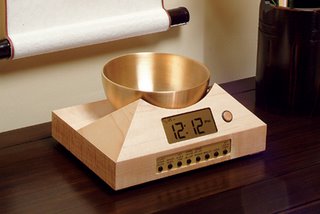 Zen Timepiece, a brass singing bowl clock and timer for meditation Now & Zen
743 Pine St.
Boulder, CO 80302
(800) 779-6383
Posted in Bamboo Chime Clocks, intention, Meditation Timers, mindfulness practice, Now & Zen Alarm Clocks, Well-being, Zen Timepiece by Now & Zen, Zen Timers
 mindfulness meditation Put it into Practice.
Mindfulness requires concentration, but rather than concentrate on any one object, we concentrate on the moment and whatever is present in that moment.
To begin, take a comfortable seat. Set your Zen Timer for 20 minutes. Bring attention to your breath by placing your awareness at your belly and feeling it rise and fall. This will help you tune in to the sensorial presence of the body. Once you
feel settled, widen your awareness to include all the sensations in your body as well as any thoughts or feelings.
Imagine yourself as a mountain. Some thoughts and feelings will be stormy, with thunder, lightning, and strong winds. Some will be like fog or dark, ominous clouds. Inhaling, note “mountain.” Exhaling, note “stable.” Use the breath to focus on the present moment; cultivate the ability to weather the storm. If you find yourself swept up in
a thought or emotion, notice it and simply return to the breath. The key is to pay attention to the ever-changing process of thinking rather than to the contents of your thoughts. As you begin to see that they are indeed just thoughts, they will begin to lose their power. You will no longer believe everything you think! Continue to watch and become mindful of your thoughts, feelings, and sensations for 5 to 20 minutes. Remember to set your Zen Timepiece to signal the end to this meditation.
adapted from Yoga Journal, by Kelly McGonigal
 Zen Timepiece, a meditation timer with bowl/gong Now & Zen
1638 Pearl Street
Boulder, CO 80302
(800) 779-6383
Posted in Bamboo Chime Clocks, intention, Meditation Timers, Meditation Tools, mindfulness practice, Now & Zen Alarm Clocks, Well-being, Zen Timepiece by Now & Zen, Zen Timers
 how to cultivate compassion Cultivate equanimity in the face of life’s ups and downs, and find deeper access to joy.
A lot of people I know avoid reading the paper first thing in the morning—being confronted with all of the injustices and bad deeds in the world is an unsettling way to start the day. It’s difficult to read about the latest corporate finance scam or the obscenity of human trafficking and keep your peace of mind, and it’s even harder to know how to respond. The conflict feels even more immediate when you witness an unjust act firsthand, or are yourself the recipient of one, whether it’s having your wallet stolen, your car broken into, or any sort of hurtful behavior directed your way. The answer to this problem could be upeksha, the fourth of the brahmaviharas.
This understanding of upeksha as equanimity stresses the importance of balance. A balanced heart is not an unfeeling heart. The balanced heart feels pleasure without grasping and clinging at it, it feels pain without condemning or hating, and it stays open to neutral experiences with presence. Insight meditation teacher Sharon Salzberg speaks of equanimity as a “spacious stillness of mind,” within which we can remain connected to others and all that happens around us, while remaining free of our conditioned habit of grasping at the pleasant and pushing away the unpleasant.
Calm Within
One way to experience equanimity is to experiment with mindfulness meditation. Rather than fixing attention on a single object such as the breath or a mantra, mindfulness meditation involves the moment-to-moment awareness of changing objects of perception. Mindfulness is like a floodlight, shining awareness on the whole field of experience, including sensations, emotions, and thoughts as they arise and pass away in the dynamic, ever-changing flux that characterizes the human experience of body and mind. Mindfulness allows you to see the nature of the unfolding process without getting caught in reactivity, without identifying with your sensations, emotions, and thoughts. This insight changes your relationship to the mind-body. The waves keep coming, but you don’t get swept away by them. Or as Swami Satchidananda often said, “You can’t stop the waves, but you can learn to surf!” This ability to remain balanced amidst ever-changing conditions is the balance of equanimity.
 How to be calm within There’s an old story that illustrates the wisdom of this state of mind. A farmer’s most valuable asset is the one horse he owns. One day it runs away. All the townspeople commiserate with him, “Oh, what terrible luck! You’ve fallen into poverty now, with no way to pull the plow or move your goods!” The farmer merely responds, “I don’t know if it’s unfortunate or not; all I know is that my horse is gone.”
A few days later, the horse returns, and following it are six more horses, both stallions and mares. The townspeople say “Oh! You’ve struck it rich! Now you have seven horses to your name!” Again, the farmer says, “I don’t know if I’m fortunate or not; all that I can say is that I now have seven horses in my stable.”
A few days later, while the farmer’s son is trying to break in one of the wild stallions, he’s thrown from the horse and breaks his leg and shoulder. All the townspeople bemoan his fate: “Oh, how terrible! Your son has been so badly injured, he’ll not be able to help you with the harvest. What a misfortune!” The farmer responds, “I don’t know if it’s a misfortune or not; what I know is that my son has been injured.”
Less than a week later, the army sweeps through town, conscripting all the young men to fight in a war…all except for the farmer’s son, who is unable to fight because of his injury.
The fact is, you can’t know what changes your life will bring or what the ultimate consequences will be. Equanimity allows for the mystery of things: the unknowable, uncontrollable nature of things to
be just as they are. In this radical acceptance lies peace and freedom—right there in the midst of whatever pleasant or unpleasant circumstances we find ourselves in. When we open to the truth that there is actually very little we can control other than our own reactions to circumstances, we learn to let go. Cultivating the qualities of kindness, compassion, and joy opens your heart to others. Equanimity balances the giving of your heart’s love with the recognition and acceptance that things are the way they are. However much you may care for someone, however much you may do for others, however much you would like to control things or you wish that they were other than they are, equanimity reminds you that all beings everywhere are responsible for their own actions, and for the consequences of their actions.
Without this recognition, it’s easy to fall into compassion fatigue, helper-burnout, and even despair. Equanimity allows you to open your heart and offer love, kindness, compassion, and rejoicing, while letting go of your expectations and attachment to results. Equanimity endows the other three brahmaviharas with kshanti: patience, persistence, and forbearance. So, you can keep your heart open, even if the kindness, compassion and appreciative joy you offer to others is not returned. And when you are confronted with the nonvirtuous deeds of others, equanimity allows you to feel compassion for the suffering that underlies their actions as well as for the suffering their actions cause others. It is equanimity that brings immeasurability or boundlessness to the other three brahmaviharas.
adapted from Yoga Journal Magazine, by By Frank Jude Boccio
Frank Jude Boccio is a teacher of yoga and Zen Buddhism and the author of Mindfulness Yoga. Find him at mindfulnessyoga.net
Use our unique “Zen Clock” which functions as a Yoga & Meditation Timer. It features a long-resonating acoustic chime that brings your meditation or yoga session to a gradual close, preserving the environment of stillness while also acting as an effective time signal. Our Yoga Timer & Clock can be programmed to chime at the end of the meditation or yoga session or periodically throughout the session as a kind of sonic yantra. The beauty and functionality of the Zen Clock/Timer makes it a meditation tool that can actually help you “make time” for meditation in your life. Bring yourself back to balance.
 Zen Clock with Gentle Chime to Awaken You Gradually Now & Zen’s Clock and Meditation Timer Store
1638 Pearl Street
Boulder, CO 80302
(800) 779-6383
Posted in Goodness, intention, Meditation Timers, Meditation Tools, mindfulness practice, prayer, Well-being, Zen Timers
 Warm winter sun “Imagine yourself outside on a beautiful Saturday afternoon, just in the flow, enjoying life. Suddenly the sun disappears behind a cloud that you didn’t know was there. It’s dark now, and you feel off kilter, sad.”
That’s how LeNeva Spires, who works as an executive assistant at a university in Portland, Oregon, describes the seasonal affective disorder (SAD) that affects her every autumn.
Though classified as a type of depression, “it feels more like something is missing, like things are not quite right,” says Spires.
It’s precisely brightness (or rather, the lack of it) that triggers this mood disorder, one of few health problems tied to a season. SAD primarily affects people who live in northern latitudes (above San Francisco and Washington, D.C.), and more women than men. It often begins in September or October, as the days shorten, and lingers until spring.
SAD tends to respond readily to the very thing we’re missing in the winter months: light. Learn how to get more of it as well as discover the best foods, exercise, supplements, and herbs to create your action plan for a brighter, happier winter.
1. Let There Be Light
For seasonal depression and the winter blahs, “the treatment of choice is light,” says psychiatrist Alfred Lewy. How do you get that light? You could move closer to the equator, where the sun rises and sets at a more consistent time all year long. Or, if your family and work life allow it, you could change your sleep schedule during the winter so you wake up a half-hour after sunrise (check your local paper to find out when the sun rises), and then go immediately outside.
But for most of us, the easiest option is to purchase a light box outfitted with special bulbs that mimic the brightness of the morning sun. Light therapy works by getting our sleep-wake cycle to synchronize with an electric-powered “sun,” thereby resetting our circadian clock. We tend to feel our best when we wake with the dawn, and the light box essentially helps you make your own dawn.
Light-Box Lowdown
Available online and at specialty stores (starting at about $160), light boxes are safe to use at home, whether or not you have an official diagnosis of SAD. Lewy recommends placing the light box at a 45-degree angle to you, from either the side or above, and starting with a morning dose of light: about 30 minutes, taken between 6 a.m. and 8 a.m. Some people may need more time — 45 minutes, or even up to two hours — but once they feel an improvement in their mood, they can reduce the sessions to 30 minutes.
The light receptors that help rest our circadian clocks reside in our eyes, so keep your eyes open during light treatment. In fact, Lewy suggests glancing sideways at the lightbulbs once or twice every minute (something you should never do with the real sun).
A small number of SAD sufferers respond best to early-evening light treatments. After a week or two of morning treatment, if you notice no improvement even with two-hour doses, try the evening sessions instead, suggests Lewy. People usually begin to feel better within a few days but should keep up the treatments daily, ideally from the onset of symptoms (usually in September or October) through at least March.
 bring on the night 2. Bring On the Night
You need a good night’s sleep in order to mitigate winter depression — and by “good,” Emmons means sleeping for eight or nine hours a night — but not more. Keep bedtime and wake-up time consistent, too; Emmons suggests going to bed between 10 and 11 p.m. and rising between 6 and 7 a.m.
Melatonin Matters
While light-box therapy remains the primary remedy for synchronizing your sleep patterns, supplementing with melatonin (the “darkness” neurotransmitter) may help, too. The brain’s melatonin levels rise to their highest level at night, and people normally start secreting the hormone a few hours before bedtime, to prime the body for sleep.
Like light therapy in the morning, taking melatonin supplements in the afternoon can help shift the circadian clock. In fact, Lewy often prescribes both morning light and 0.3 mg to 0.5 mg of melatonin in the afternoon for best results in resyncing the circadian processes. Since melatonin can make some people sleepy, avoid driving as you figure out the best dosage. You’ll find melatonin tablets at natural-foods stores.
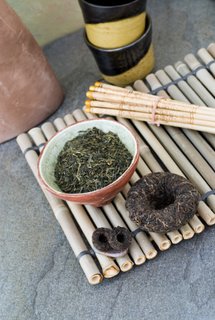 eat well 3. Eat to Feel Good
What we eat can affect our brain chemistry and our mood. To combat SAD, Emmons recommends focusing on foods that increase and stabilize levels of serotonin, a mood-improving hormone that tends to decrease in the winter. These foods include choices rich in tryptophan, a building block of serotonin.
We often crave high-carbohydrate comfort foods in winter, but it’s wise to resist the urge, he says. As he explains it, indulging in refined carbs, such as white bread and white rice, may indeed offer an initial feel-good spike in serotonin levels. But, as with a sugar rush, refined carbs end up depleting our serotonin levels soon after.
Instead, eat a variety of complex carbohydrates, such as barley, brown rice, oats, and other whole grains, and include a small amount of lean protein, ideally a high-tryptophan protein (turkey, cheese, eggs) at each meal or snack. Also include leafy green vegetables, such as kale and bok choy, which provide mood-supporting B vitamins and minerals that help convert tryptophan into serotonin.
4. Move and Stretch
“Exercise helps [all types of depression] for many reasons,” says Emmons. It boosts serotonin levels in the brain; it improves circulation, which gets more blood and nutrients to the brain; it increases energy and metabolism, even at the cellular level; and it improves glucose regulation, which also affects energy levels.
For those taking antidepressant medication, exercise helps improve the effectiveness of the drug, likely by improving circulation. More of the medicine gets to the brain, where it’s needed, and the body metabolizes the drug more easily, which reduces side effects.
The best news about SAD and exercise, says Emmons, is that you don’t have to take your workout to the extreme. Mild aerobic exercise for 30 minutes can usually lighten your mood. If it’s not too cold, walking outdoors is a great option. At the gym, try the stationary bike or treadmill for a half-hour every day.
5. Supplement Smartly
Several dietary supplements can help fill in any nutritional gaps and in turn may lift your mood. Emmons says his clients have had success with the following four:
Vitamin D
Deficiency in this vitamin is extremely common and may contribute to both ordinary and seasonal depression (along with other illnesses). While light boxes substitute for the sun in certain ways, they don’t provide this critical nutrient (which is more of a hormone than a vitamin). In the winter, a vitamin D supplement can help regulate your mood.
Dosage: 2,000 IU of vitamin D3 daily
Multivitamin
A good one includes plenty of B vitamins, as well as key minerals such as selenium (which helps support mood) and magnesium (which reduces anxiety and muscle tension).
Dosage: 1 daily
B-Vitamin Complex
These assist the brain in producing neurotransmitters such as serotonin and norepinephrine.
Dosage: One B-50 supplement daily (along with the multivitamin)
Omega-3-Rich Fish Oil
Studies suggest that omega-3 fatty acids may help prevent and ease depression and other mood disorders. Flax makes a good substitute for strict vegetarians.
Dosage: 1,000 mg of fish oil in capsule form twice daily, or 1 tablespoon of flax oil twice a day
6. Take It Outside
 go outside to cheer up Spending time outdoors helps us reconnect with nature, says Emmons, thus healing a rift that seems to lie at the heart of seasonal depression. If you combine a serotonin-boosting exercise with your outdoor time — like a brisk walk at a local park or an afternoon of cross-country skiing — you’re combating the winter blues on two fronts.
During the summer, take advantage of the sunlight by spending 15 to 20 minutes a day in the sun without sunscreen (unless you’re at risk of skin cancer). This will help build your vitamin D levels for next year.
7. Try Healing Herbs
Certain medicinal plants ease the winter blues, says Margi Flint, who runs the Earthson Herbals school in Marblehead, Massachusetts.
Uplifting Tea
For a mild, mood-boosting infusion, simmer 1 ounce oatstraw in 1 quart of water for 40 to 60 minutes. Remove from heat, add 2 tablespoons of dried chamomile and 2 tablespoons of dried lemon balm; cover and steep for 15 minutes. Strain and drink several cups daily.
Aromatherapy
Since the smell of any citrus uplifts the spirit, add a total of 10 drops of any combination of lemon, lime, and orange essential oils to each ounce of lotion or massage oil. Use daily, or use these oils in a diffuser.
Daily Tonic
Holy basil, ashwaganda, and gotu dola — from India’s traditional system of medicine, Ayurveda — help ease depression. Flint suggests using the powdered form; add a 1/4 teaspoon of each to oatmeal or applesauce.
8. Don’t Go It Alone
As with any form of depression, working with a mental-health professional for SAD can be beneficial. If you experience suicidal thoughts or other serious symptoms, seek help immediately.
One of the ultimate Zen like experiences is waking-up from a great slumber refreshed and energized. Your mind and body are harmoniously one, both alert and focused. Having a refreshed mind and body are two keys to a natural and Zen lifestyle. Waking up in the morning should not be a loud and abrupt awakening, but rather it should be a peaceful positive experience. The right natural alarm clock can transition your deep and tranquil sleep into a serene start to consciousness. Imagine a long-resonating Tibetan bell-like chime waking you up to a beautiful morning experience.
The right alarm clock can be the most beneficial investment for you. With our Now & Zen natural alarm clock you are awakened more gradually and thus more naturally. Now & Zen is focused on creating a naturalistic lifestyle, and our clocks are an example of our philosophy.
adapted from Body + Soul, January/February 2009
 Bamboo Alarm Clocks & Meditation Timers
Now & Zen – Gradual Chime Alarm Clock Store
1638 Pearl Street
Boulder, CO 80302
(800) 779-6383
Posted in Goodness, Insomnia, intention, sleep, Sleep Habits, Well-being, Zen Timers
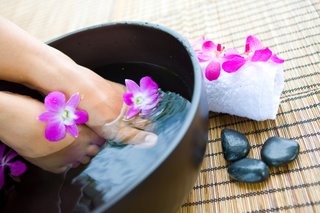 feet in foot spa bowl with orchids After a busy week, why not treat yourself like a flower in need of some care and pampering?In the healing tradition of Ayurveda, we’ve have created a rejuvenating summer routine that you can do at home on a weekend — one that consists of such indulgent pleasures as soothing masks, herbal baths, calming yoga poses, and seasonal meals. Come Monday morning, no matter what, you’ll emerge feeling refreshed, collected, and looking your best.
Morning Yoga
Greet the day with a gentle yoga routine. Poses such as Bow Pose, Downward Dog, and spinal twists help balance pitta.
Breakfast
For the first meal on each of these two days, eat a large bowl of fruit salad with a tall glass of freshly squeezed orange juice. This meal will help your body get rid of accumulated toxins. If you find orange juice too acidic, you may substitute pitta herbal tea (available at Indian grocery stores) or any other fresh fruit juice of the season. You may also prepare a blended fruit smoothie in place of the fruit salad. In a blender, combine a large banana with 1/2 cup of your choice of seasonal fresh fruits and 1/2 cup of water to thin it out.
Spa Treatments
Spend an hour or two luxuriating in the pitta-balancing spa treatments. On Saturday, you’ll focus on your skin and body; on Sunday, you’ll treat the hair, hands, and feet.
Down Time
Spend the late part of the morning as you like — reading an interesting book, listening to music, writing in your journal, gardening, painting. The choices are endless. It is important, though, to spend time unwinding and doing what you want rather than what you think you should do.
Lunch
After your morning yoga and spa therapies, enjoy a large raw salad made with fresh seasonal green vegetables such as cucumber, celery, and sprouts. Choose pitta-balancing herbs and spices like cilantro and basil to add flavor. Eat your lunch slowly and mindfully, focusing on the flavors and textures of the ingredients. To unlock your mind, reflect on the view from your window, or even the sight of indoor plants and flowers, while you eat.
 - treat yourself to some rest
Rest
Exercise
Your retreat will be enhanced by a brisk walk, preferably in the open air so you can breathe fresh oxygen directly into your lungs. Stay conscious of good posture, and warm up by starting out at a slow pace then building to a brisk pace. Keep your chest out, swing your arms wide, and breathe through your mouth. Walk for 20 to 30 minutes. If you prefer, swimming is also a good exercise for balancing pitta.
Digestive Meditation and Care
This is an ideal time to tune in to and become familiar with your digestive system. Place your hands first on your stomach and become aware of any slight movements, feelings, or sounds. Do the same with your small intestines in your midriff area and then with the area under your navel. Mentally prepare for your next meal by noticing whether you are hungry or not. Resolve to eat only as much as you need to fill three-quarters of your stomach (this typically translates to about as much food as will fit into both your cupped hands). Using a little bit of oil, massage your stomach in round circles, moving clockwise. This will help you digest the last meal and prepare your body for the next.
Dinner
Dinner during the retreat should consist of steamed vegetables. As with lunch, use fresh, green seasonal vegetables — the greener the better. For extra flavor, add fresh herbs such as rosemary, basil, parsley, and sage, or pine nuts, sesame seeds, or pumpkin seeds. As with lunch, eat slowly and mindfully, which will allow for complete digestion. An hour or so after dinner, enjoy an herbal tea.
 Bath and Bedtime Bath and Bedtime
Run a bath prepared with ingredients to balance pitta — rose, neem, jasmine, basil. You may use fresh or dried leaves and herbs; bundle a handful of ingredients in a piece of muslin cloth to make a tea bag for your tub. Or, if you prefer, add a few drops of essential oils directly to the bathwater. If you like, use candles, fresh flowers, and music to aid relaxation. As you soak in the bath, close your eyes and breathe deeply, releasing tension with each exhalation. Keep yourself warm after the bath and go to bed, relaxed and at peace.Rest is important to calm the mind and allow the physical body to deal with fatigue. After eating, take some quiet time to listen to music, read, or take a short nap for half an hour to an hour if you are sleepy. If you are tired but cannot fall asleep, then simply rest your mind and body by lying down and emptying your mind of thoughts.
One of the ultimate Zen like experiences is waking-up from a great slumber refreshed and energized. Your mind and body are harmoniously one, both alert and focused. Having a refreshed mind and body are two keys to a natural and Zen lifestyle. Waking up in the morning should not be a loud and abrupt awakening, but rather it should be a peaceful positive experience. The right natural alarm clock can transition your deep and tranquil sleep into a serene start to consciousness. Imagine a long-resonating Tibetan bell-like chime waking you up to a beautiful morning experience.
The right alarm clock can be the most beneficial investment for you. With our Now & Zen natural alarm clock you are awakened more gradually and thus more naturally. Now & Zen is focused on creating a naturalistic lifestyle, and our clocks are an example of our philosophy.
adapted from Body + Soul, June 2005
Now & Zen – The Zen Alarm Clock Store
1638 Pearl Street
Boulder, CO 80302
(800) 779-6383
 Now & Zen's Family of Products
Posted in intention
 Use Your Soothing Chime Alarm Clock - Kiyonaga Torii, Beauties in September Whenever my husband tells one of his legendary bedtime stories, it’s as if our entire world slows to a crawl. It doesn’t matter if the plot hangs on the genius of Detective Victor Garcia and his whip-smart daughter Inez — or the pranks of Captain Giggles, who’s inclined to put Jell-O in people’s rain boots when they least expect it. The minute Chris settles into his chair, gathering that first sentence in his imagination, our three girls hold their collective breath. The house falls silent.
What makes these moments so enchanting isn’t just his storytelling mastery. It’s also the timelessness it evokes. Lost in the spell of the latest adventure, his enraptured audience wants nothing more than for the tale to unravel slowly. If they had their wish, it would go on for hours.
My kids, like all kids, have that famously easy way of getting lost in a moment. The truth about these stories, though, is that our everyday life too often crowds them out — the mountains of laundry, the getting to work on time, the broken dryer, the doctor’s appointments. Despite wanting to wallow in stretches of downtime, I often feel as if chaos lurks just around the corner — and I know I’m not alone. Coworkers, neighbors, friends, the woman at the checkout counter, the post-office guy, my yoga teacher — they all knowingly roll their eyes these days at the mere mention of “busy.” It seems we’re all aching for more breathing room. Somehow, though, despite our best intentions, we can’t seem to find it.
The idea of a national time crunch isn’t new, of course. The public hand-wringing actually began decades ago, as researchers revealed the serious health consequences of the then-novel “24/7 lifestyle.” But since then, the problem has reached epidemic proportions. “Every woman I talk to these days tells me she’s exhausted,” says Kathleen Hall, founder of The Stress Institute in Clarkesville, Georgia, and author of “A Life in Balance and Alter Your Life.” But it’s not only our health that suffers — it’s our happiness, too. Living on overdrive squeezes out the breathing room we need to appreciate any given moment. As we rush through life, it passes us by.
The effect can feel a bit like being swept into white-water rapids. “But we’re not as helpless as we think,” says Cecile Andrews, author of “Slow Is Beautiful: New Visions of Community, Leisure, and Joie de Vivre” and an active member of Take Back Your Time, a group heading a national effort to address America’s time famine. As she and other experts explain it, finding more time isn’t about getting skilled at cramming everything in. Instead, it involves looking at the problem — and also ourselves — with a fresh perspective. By identifying what truly makes us happy and recognizing how our choices affect our lives, we can keep the big picture of our life path in full view. Then, says Andrews, “we can all take a breath and begin to slow down.”
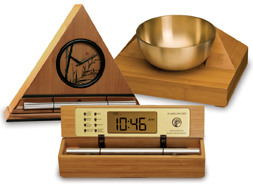 Chime Alarm Clocks and Timers for Meditation & Yoga One of the ultimate Zen like experiences is waking-up from a great slumber refreshed and energized. Your mind and body are harmoniously one, both alert and focused. Having a refreshed mind and body are two keys to a natural and Zen lifestyle. Waking up in the morning should not be a loud and abrupt awakening, but rather it should be a peaceful positive experience. The right natural alarm clock can transition your deep and tranquil sleep into a serene start to consciousness. Imagine a long-resonating Tibetan bell-like chime waking you up to a beautiful morning experience.
The right alarm clock can be the most beneficial investment for you. With our Now & Zen natural alarm clock you are awakened more gradually and thus more naturally. Now & Zen is focused on creating a naturalistic lifestyle, and our clocks are an example of our philosophy.
adapted from Body + Soul, October 2006 by Jennifer Barrett
 Gradual, Soothing Chime Alarm Clocks - Boulder, Colorado Now & Zen’s Gradual and Soothing Chime Alarm Clock Store
1638 Pearl Street
Boulder, CO 80302
(800) 779-6383
Posted in intention
 How to feel more compassionate Maitryadisu balani
The cultivation of friendliness creates inner strength. (Yoga Sutra III.24)
We typically think of our emotional range as something that is fixed and unchanging—a reflection of the personality we’re born with. But research is revealing the possibility that we may be able to cultivate and increase our ability to feel the emotional state of compassion. Researchers have found that feeling connected to others is as learnable as any other skill. “We are trying to provide evidence that meditation can cultivate compassion, and that you can see the change in both the person’s behavior and the function of the brain,” Lutz says.
So what does compassion look like in the brain? To find out, Lutz and his colleagues compared two groups of -meditators—one group whose members were experienced in compassion meditation, and the other a group whose members were not—and gave them the same instructions: to generate a state of love and compassion by thinking about someone they care about, extend those feelings to others, and finally, to feel love and compassion without any specific object. As each of the participants meditated in-side the fMRI brain scanners, they were occasionally interrupted by spontaneous and unexpected human sounds—such as a baby cooing or a woman screaming—that might elicit feelings of care or concern.
All of the meditators showed emotional responses to the sounds. But the more experienced compassion meditators showed a larger brain response in areas important for processing physical sensations and for emotional responding, particularly to sounds of distress. The researchers also observed an increase in heart rate that corresponded to the brain changes. These findings suggest that the meditators were having a genuine empathic response and that the experienced meditators felt greater compassion. In other words, compassion meditation appears to make the brain more naturally open to a connection with others.
These meditation techniques may have benefits beyond the experience of spontaneous compassion. A study by psychology professor Barbara Fredrickson and her colleagues at the University of North Carolina, Chapel Hill, and the University of Michigan, found that a seven-week lovingkindness meditation course also increased the participants’ daily experience of joy, gratitude, and hope. The more participants meditated, the better they felt. Participants also reported a greater sense of self-acceptance, social support, purpose in life, and life satisfaction, while experiencing fewer symptoms of illness and depression. This study provides strong evidence that chipping away at the illusion of separation can open us up to a far more meaningful connection to life.
adapted from Yoga Journal, by Kelly McGonigal
Use our unique “Zen Clock” which functions as a Yoga & Meditation Timer. It features a long-resonating acoustic chime that brings your meditation or yoga session to a gradual close, preserving the environment of stillness while also acting as an effective time signal. Our Yoga Timer & Clock can be programmed to chime at the end of the meditation or yoga session or periodically throughout the session as a kind of sonic yantra. The beauty and functionality of the Zen Clock/Timer makes it a meditation tool that can actually help you “make time” for meditation in your life. Bring yourself back to balance.
 Zen Timers and Gentle Alarm Clocks Now & Zen – The Chime Timer Store
1638 Pearl Street
Boulder, CO 80302
(800) 779-6383
Posted in Chime Alarm Clocks, intention, Meditation Timers, Meditation Tools, mindfulness practice, Now & Zen Alarm Clocks, Well-being, zen, Zen Timers
 set your zen timer for a mini-meditation Memorize a three-to-five-word phrase, a mantra, that will bring you back to center when things get rough, such as “I am strong” or “Spirit will guide me.” Also, keep a peaceful image mentally on hand (a beach scene, a quiet forest) to call up in stressful moments. Set your Digital Meditation Timer with Chime for 5 minutes and sit silently repeating your phrase until the calming chime sounds.
adapted from Body + Soul Magazine
 digital timers for meditation and yoga with chime Now & Zen – The Meditation Timer Store
1638 Pearl Street
Boulder, CO 80302
(800) 779-6383
Posted in Chime Alarm Clocks, intention, Meditation Timers, Meditation Tools, mindfulness practice, Well-being, Zen Timers
Research published in the last two years shows that certain slow activities–like gentle yoga or gardening–can reduce your stress level and blood pressure and improve your body’s ability to regulate sugar. Past studies have shown that other habits like meditation can help reduce chronic pain and enhance mental clarity. The first step to finding “slowness”is to clear some room in your life–watch less TV or spend less time browsing at the mall. “Jettison the clutter that clogs up your schedule,” says Carl Honoré, author of In Praise of Slowness (HarperOne, 2004). “When you focus on the things that are important at work or at home you can enjoy those things more,”he says. You can also take a more relaxed approach to the things you already do and adopt new habits that require mindfulness. “It’s one thing to say you’re going to slow down, but a slow hobby helps you put those words into practice,” says Honoré. To get you started we’ve come up with seven ways to destress and reenergize.
 gardening is a great mindfulness practice that cultivates stillness of mind 1. Become a Gardener
Caring for flowering plants may help you relax and get grounded. In 2004, researchers at Japan’s Utsunomiya University found repotting plants lowered fatigue and promoted physiological relaxation in study participants, and that working with flowers seemed to have a stronger positive effect than working with nonflowering plants.
HEALTH BENEFITS Research shows that exposure to plants–and even just looking at them–can reduce blood pressure, increase concentration and productivity, and help you recover from illness, says Andy Kaufman, Ph.D., assistant professor of tropical plant and soil sciences at the University of Hawaii in Honolulu. He cites a classic 1984 study, published in Science, which showed that even the view of a green garden helped surgical patients recovering from gall bladder surgery. Among a group of 46 patients in a Pennsylvania hospital, the 23 who had rooms with windows facing greenery had shorter postoperative stays and needed fewer pain–relieving analgesics than the 23 whose windows faced a brick wall.
GETTING STARTED If you live in an apartment or don’t have much room to garden, invest in the EarthBox (earthbox.com), a self–watering container garden that comes with potting soil and fertilizer. “Even if you have a brown thumb, you can grow things [in it],”says David Ellis, American Horticulture Society spokesperson. You could also join a community garden; visit ahs.org, the American Horticulture Society’s website, for more info.
 yoga helps to slow us down 2. Practice Slow Yoga
Slow yoga emphasizes one drawn–out breath for each movement you make. Like tai chi, it uses many repetitive flowing moves. “When you practice slow yoga, you create more awareness between mind and body,”says Beth Shaw, founder of Yoga Fit Training Systems in Los Angeles. This creates a deep sense of stillness and helps develop patience and lower stress, she adds.
HEALTH BENEFITS Last year, researchers in Sweden and India showed that practicing yoga can reverse the negative effects of high blood pressure, obesity, and high blood sugar. The studies, published in the journal Diabetes Research and Clinical Practice, showed reduced waist circumference, blood pressure, blood sugar, and triglycerides (the chemical form of fat cells) and higher HDL (so–called good cholesterol) levels in a control group that practiced yoga versus a placebo group.
GETTING STARTED To find a Slow Yoga class near you visit yogafit.com or inquire at your local yoga studio. You might also consider restorative or yin yoga, two other gentle forms of the practice.
 Take a nap 3. Take a Nap
You snooze, you win, according to a Harvard study published last year in The Archives of Internal Medicine. Researchers revealed that people who regularly napped at least three times a week for an average of 30 minutes had a 37 percent lower risk of heart attack than those who didn’t nap. “It shows that napping is an important preventive strategy just like regular exercise, eating right, and not smoking,”says Sara C. Mednick, Ph.D., author of Take a Nap! Change Your Life (Workman, 2006).
HEALTH BENEFITS A daily nap also boosts serotonin, says Mednick, which may lead to improved memory and performance. Napping can even contribute to weight loss, according to a study in the American Journal of Physiology, Endocrinology, and Metabolism in 2007. That study looked at hormone levels in 41 men and women who were part of a seven–day sleep–deprivation experiment. Those allowed to nap for two hours following a night without any sleep showed a significant drop in cortisol, a hormone related to high levels of stress, and a complement of growth hormone, which helps regulate insulin and fat storage. Researchers concluded that a midafternoon nap improves alertness and performance and reverses the negative metabolic effects of sleep loss.
GETTING STARTED The best time to nap is between 1 p.m. and 3 p.m., but a 15– to 20–minute power nap at any time can help. Set your Zen Alarm Clock for 20 minutes. Close the office door and take a snooze, or find a quiet place where you feel safe. Nap on weekends, Mednick says. “Just don’t use the weekend to catch up on sleep lost in the week.”Check with your doctor about napping if you’re being treated for insomnia.
4. Start a Slow Hobby
 learning to paint Hobbies that require mindful, solitary activity–such as knitting, painting, sculpting, crocheting, or quilting–can act as a brake on your hectic pace.
HEALTH BENEFITS “Slow hobbies help you cultivate the lost art of concentration and being in the moment. They have a meditative quality to them,”says author Carl Honorè. “And that calming effect goes beyond the act itself. Maintaining that inner stillness enables you to negotiate the fast–moving waters of the rest of your day.”
GETTING STARTED Sixty–four percent of people who knit or crochet say they use these crafts to help them reduce stress and relax, according to the Craft Yarn Council of America. Visit craftyarncouncil.com for information. To learn about drawing, visit drawspace.com. Check with a local college or community center for other craft classes.
5. Eat Slowly
Eating too fast creates stress in the body, says nutritionist Marc David, author of The Slow Down Diet (Healing Arts Press, 2005). That causes a spike in cortisol and insulin, which in turn diminishes your ability to burn calories and makes you more likely to gain weight. Eating quickly also leads to overeating. “The brain demands more food if it doesn’t have time to register its needs for taste, aroma, and satisfaction,”says David.
HEALTH BENEFITS Taking time to eat creates a relaxation response, which means you’ll have fewer digestive complaints and your body will be able to take in the nutrients it needs. Plus “we make better food choices, and we know when to stop,”he adds.
GETTING STARTED To ease the pace, double the time you spend on your meals; for example, if you usually eat breakfast in five minutes, stretch it out to ten. “Focus on your food: Taste it, enjoy it, notice it, savor it,”says David. “Find relaxed time between bites by slowing down your internal conversation. Let go of any sense of urgency, and allow the moment to be sensual.”The cooking process can help you slow down too, says David. “Instead of microwaving something, make a soup from scratch.”
6. Do One Thing at a Time
A lot of us believe we get more done by multitasking. But research at the University of Michigan published in the Journal of Experimental Psychology in 2001, shows the opposite is true. “If you concentrate on one task at a time, you get more done faster and make fewer mistakes,” says David E. Meyer, director of the Brain, Cognition, and Action Laboratory at the University of Michigan.
HEALTH BENEFITS Taking on chores one at a time reduces chronic stress and protects your short–term memory, which comes under fire if the brain is overtaxed.
GETTING STARTED To curb outside distractions and focus better, set aside time when you can concentrate on one activity from start to finish. For example, check e–mail once an hour and turn off your instant messaging; let your phone messages go to voice mail and only check them occasionally throughout the day.
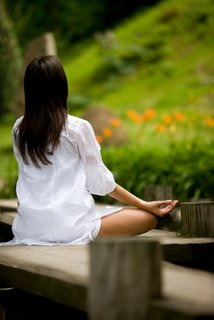 practice meditation in order to slow down 7. Meditate
“Meditation teaches us to focus,”says Steven Hartman, director of professional training at the Kripalu Health and Yoga Center (kripalu.org) in Stockbridge, Mass. “All day your mind is chattering. When you meditate, you can hear your own inner wisdom.”
HEALTH BENEFITS Studies have shown that practicing meditation also improves blood pressure, fortifies the immune system, and promotes a sense of well–being. “A daily meditation practice can bring body, breath, mind, and spirit into balance,”says Hartman.
GETTING STARTED Check out a program like Transcendental Meditation. (See tm.org.) Or begin at home: “Put an egg timer on and stay with your breath for just two and a half minutes,”says Hartman. “Keep your spine tall and straight and allow the breath to be natural.”If you’re seated on the floor, a cushion can raise your pelvis and bring your spine into a natural position. As you get comfortable with the practice, you can increase your time to 15 or 30 minutes a day.
adapted from Natural Health Magazine, by Chrystle Fiedler
One of the ultimate Zen like experiences is waking-up from a great slumber refreshed and energized. Your mind and body are harmoniously one, both alert and focused. Having a refreshed mind and body are two keys to a natural and Zen lifestyle. Waking up in the morning should not be a loud and abrupt awakening, but rather it should be a peaceful positive experience. The right natural alarm clock can transition your deep and tranquil sleep into a serene start to consciousness. Imagine a long-resonating Tibetan bell-like chime waking you up to a beautiful morning experience.
The right alarm clock can be the most beneficial investment for you. With our Now & Zen natural alarm clock you are awakened more gradually and thus more naturally. Now & Zen is focused on creating a naturalistic lifestyle, and our clocks are an example of our philosophy.
 Zen Meditation Timers with Soothing Chime Now & Zen – Soothing Chime Alarm Clock & Timer Store
1638 Pearl Street
Boulder, CO 80302
(800) 779-6383
Posted in Chime Alarm Clocks, intention, Meditation Timers, Meditation Tools, mindfulness practice, Natural Awakening, Now & Zen Alarm Clocks, sleep, Sleep Habits, wake up alarm clock, Well-being, yoga, Yoga Timer, Yoga Timers by Now & Zen, Zen Alarm Clock, Zen Timers
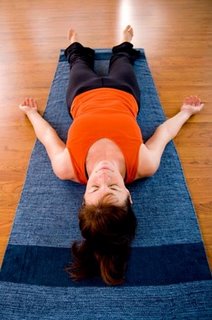 Yoga Pose 1. Lie down in the corpse pose and make yourself comfortable. Try a pillow under the head, and don’t forget a light blanket to keep drafts from drawing your attention outward.
2. Give yourself a few moments to settle, and allow your body to soften into the support of the ground. Watch the breath until it and your heart rate are steady.
3. Bring your awareness to each point listed below and allow the surrounding muscle tissues to relax.
Crown of the head
Forehead, temples
Eyebrows, eyelids, and eyes
Nose
(Focus on the breath flowing in and out of the nostrils, 2–4 times.)
Cheeks, jaw
Mouth, chin
Hollow of the throat
Sides and back of the neck
Shoulders
Upper arms, lower arms
Hands, fingers
Fingertips
(Inhale as if the breath is flowing down to the fingertips and exhale back up through the nostrils, 2–4 times)
Fingers, hands, arms
Shoulders
Chest and rib cage around the back to the spine
Heart center
(Inhale as if the breath is flowing down to the heart center and exhale back up through the nostrils, 2–4 times)
Abdomen
Sides, lower back
Hips, buttocks
Upper legs, lower legs
Feet
Toes
(Inhale as if the breath is flowing down to the toes and exhale back up through the nostrils, 2–4 times)
4. Reverse the sequence, bringing awareness up the body from the toes to the head without pausing for breath awareness at the toes, heart center, fingertips, or nose.
5. Take 10 breaths while keeping awareness spread throughout the body.
6. Make a gentle transition to your next activity.
Use our unique “Zen Clock” which functions as a Yoga & Meditation Timer. It features a long-resonating acoustic chime that brings your meditation or yoga session to a gradual close, preserving the environment of stillness while also acting as an effective time signal. Our Yoga Timer & Clock can be programmed to chime at the end of the meditation or yoga session or periodically throughout the session as a kind of sonic yantra. The beauty and functionality of the Zen Clock/Timer makes it a meditation tool that can actually help you “make time” for meditation in your life. Bring yourself back to balance.
adapted from Yoga International, Jan/Feb 2006 by Bran Cassidy
 Mediation Timers Now & Zen – The Zen Alarm Clock Store
1638 Pearl Street
Boulder, CO 80302
(800) 779-6383
Posted in intention, Meditation Timers, Meditation Tools, mindfulness practice, Zen Timers
« Previous Entries
Next Page »
|
|
|
|